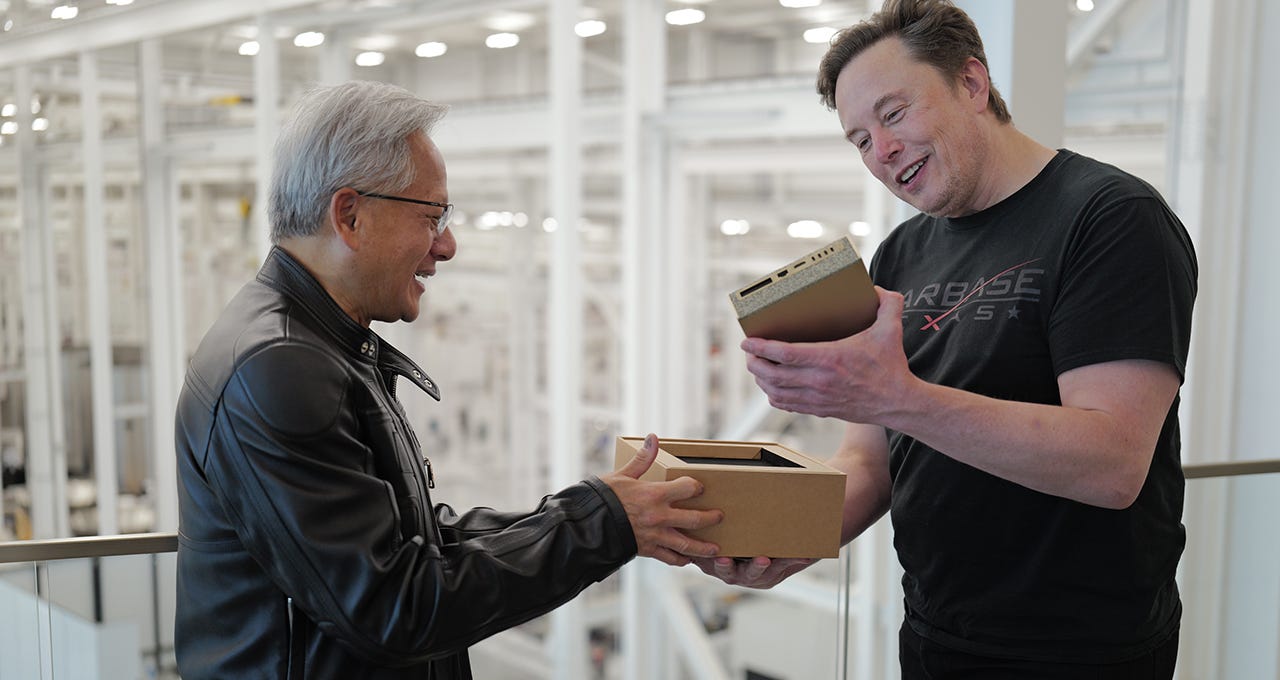Jensen Huang just hand-delivered a $4,000 desktop supercomputer to Elon Musk at SpaceX like he’s the world’s most expensive DoorDash driver.
The scene at Starbase, Texas: The world’s richest man is casually munching pizza in the SpaceX cafeteria. Kids are running around with chip bags. Engineers are prepping for the 11th Starship test. Then the CEO of the world’s most valuable company ($4.5 trillion) walks in carrying a box the size of a hardcover book.
“Remember that DGX-1 I gave you at OpenAI in 2016?” Huang says. “That helped create ChatGPT. Here’s the sequel—except this one fits on your desk.”
THE ACTUAL DEVICE SPECS (because details matter):
The DGX Spark represents a computing revolution compressed into 1.2 kilograms:
• 1 petaflop of AI compute (1,000,000,000,000,000 calculations per second)
• 128GB unified memory
• Runs 200-billion parameter models locally
• Fine-tunes 70-billion parameter models on-device
• Price: $3,999
• Size: Literally a thick textbook
For perspective: In 2016, this performance cost $10 million and required an entire server room with industrial cooling. Today it runs on your desk next to your coffee mug.
THE INSCRIPTION CEREMONY (yes, they really did this):
Jensen inscribed: “From A Single Spark, A world of Intelligent” Elon replied with: “Ad astra!” (To the stars)
Two of tech’s most powerful CEOs, exchanging philosophical Latin quotes on a tiny supercomputer while a 400-foot rocket sits outside. You cannot make this up.
WHY THIS ACTUALLY MATTERS FOR YOUR BUSINESS:
While everyone’s fighting over OpenAI API access and burning cash on AWS bills, Nvidia just democratized AI development entirely. Here’s what changes:
No more cloud dependency: Run GPT-scale models in your office
Zero latency: Everything processes locally
Complete privacy: Your data never leaves your desk
No rate limits: Run unlimited queries
Fixed cost: One payment, infinite compute (electricity bills aside)
Early recipients testing the system include:
• Microsoft, Google, Meta (the obvious ones)
• Hugging Face, Docker, Anaconda (the developer favorites)
• NYU Global Frontier Lab (for healthcare AI research)
• Cadence (for chip design acceleration)
Professor Kyunghyun Cho from NYU: “This allows us to rapidly prototype AI algorithms even for privacy-sensitive applications like healthcare—all on a desktop.”
THE STRATEGIC GENIUS BEHIND THE THEATRICS:
Huang didn’t randomly choose SpaceX. This was a masterclass in corporate messaging:
• Location: Starbase, where humanity’s Mars ambitions live
• Timing: During Starship’s 11th test flight
• Recipient: The man running Tesla, SpaceX, Neuralink, and xAI
• Message: “Your rockets reach space. My chips power what comes next.”
Remember: Musk’s xAI just built Colossus, the world’s largest AI training cluster, using 100,000 Nvidia H200 GPUs. This isn’t charity—it’s relationship maintenance at the highest level.
THE 2016 CALLBACK THAT STARTED EVERYTHING:
Nine years ago, Huang delivered the first DGX-1 to a tiny nonprofit called OpenAI. Musk was a co-founder then. That single machine, inscribed with “To the future of computing and humanity,” became the foundation for:
• GPT development
• The transformer revolution
• ChatGPT’s emergence
• The entire generative AI boom
One machine. Delivered by hand. Changed everything.
Now Huang’s doing it again, except this time to 10,000+ developers simultaneously.
WHAT DEVELOPERS CAN ACTUALLY BUILD:
This isn’t just about running ChatGPT locally. The DGX Spark enables:
• Custom AI agents that never touch the cloud
• Real-time vision models for robotics
• Medical AI that keeps patient data 100% local
• Financial models that process sensitive data on-premise
• Gaming AI that runs without server calls
It comes preloaded with:
• NVIDIA NIM microservices
• CUDA libraries
• Frameworks for FLUX.1 (image generation)
• Cosmos models (vision-language processing)
• Full development stack
THE COMPETITION SCRAMBLE:
While Nvidia ships actual hardware to developers’ desks:
• Apple’s M4 Max: Great for laptops, can’t touch this performance
• Google’s TPUs: Cloud-only, you rent them
• AMD’s MI300X: Data center only, $20,000+
• Intel’s Gaudi3: Still trying to catch up
THE HIDDEN BUSINESS MODEL:
At $3,999, Nvidia likely breaks even on hardware. The real play:
Get developers hooked on CUDA ecosystem
Lock in next generation of AI builders
Create dependency on Nvidia’s software stack
Upsell to enterprise DGX systems later ($100,000+)
It’s the razor-and-blades model, except the razor is a supercomputer.
THE NUMBERS THAT MATTER:
Nvidia stock impact: Up 3% on announcement, adding $135 billion in market cap Total addressable market: 30 million developers worldwide Potential revenue if 1% buy: $1.2 billion Ecosystem lock-in value: Priceless
ACTUAL CUSTOMER QUOTE:
“DGX-1 launched the era of AI supercomputers and unlocked the scaling laws that drive modern AI,” Huang said. “With DGX Spark, we return to that mission—placing an AI computer in the hands of every developer to ignite the next wave of breakthroughs.”
Translation: “We’re speedrunning the next ChatGPT moment, except this time from 10,000 garages simultaneously.”
YOUR ACTION ITEMS:
If you’re a developer: Order one. Today. The waitlist will be months long by Friday. If you’re a startup: This replaces your entire cloud AI budget If you’re an enterprise: Your competitors’ interns now have supercomputers If you’re an investor: Watch for the garage startups building on these
THE PUNCHLINE:
We live in a timeline where:
• A leather-jacket-wearing CEO hand-delivers supercomputers
• It happens at a rocket factory
• The recipient is simultaneously building brain chips and Mars colonies
• The device costs less than a MacBook Pro
• And it might spawn the next trillion-dollar company from someone’s dorm room
Also, imagine being the SpaceX security guard checking Huang’s visitor badge: “Purpose of visit?” “Delivering a supercomputer to Elon.” “...Sure, why not. Weirder things have happened here.”
Links for the curious:
🔗 Official announcement: nvidia.com/dgx-spark
🔗 Live updates from Starbase: blogs.nvidia.com
🔗 Technical specifications: nvidia.com/dgx-spark/specs
🔗 Pre-orders (good luck): Available through Nvidia and partners including Dell, ASUS, Lenovo, HP
The future isn’t evenly distributed yet. But at $3,999, it’s getting closer.
What would you build if you had a supercomputer on your desk tomorrow?



